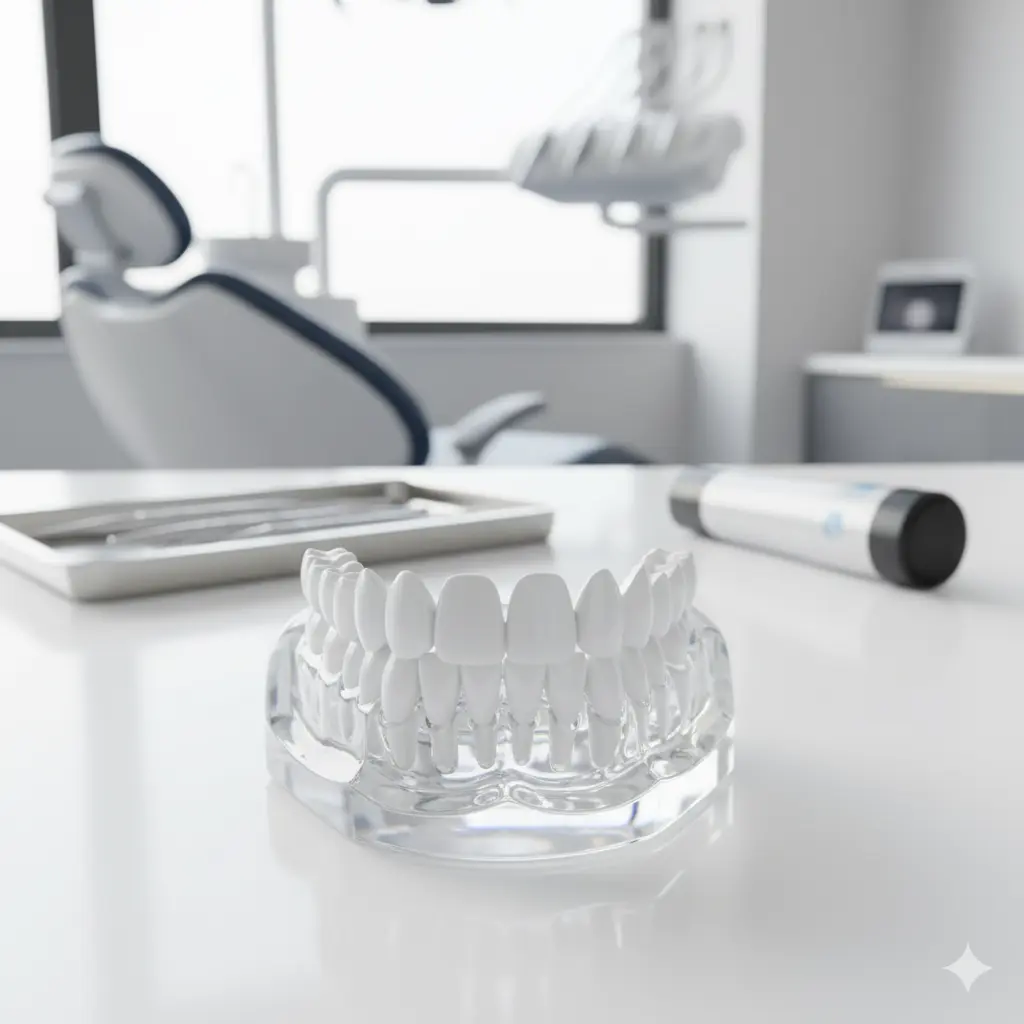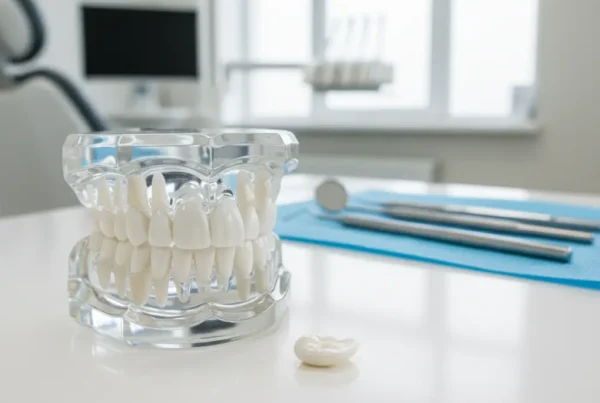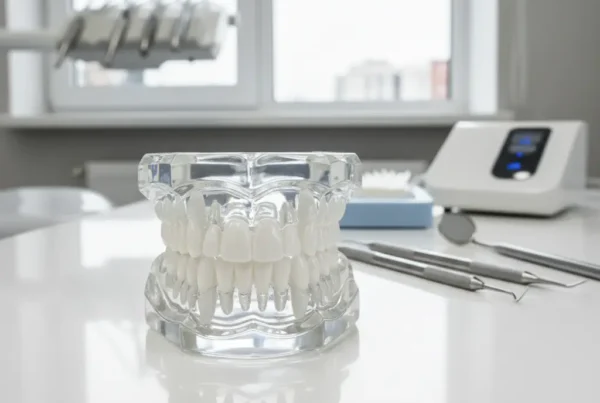Your dental veneers have transformed your smile and boosted your confidence for years now. But lately, you’ve been catching glimpses in the mirror and wondering if something looks different. Maybe you’ve noticed a small chip or your veneers don’t sparkle quite like they used to. Dr. Nazita Gaff and Dr. Brad Labrecque at Laguna Heights Dental see this exact scenario play out countless times in their Texas practice. As a fourth-generation dental family with over 30 years of combined experience in cosmetic dentistry, they understand the emotional connection patients have with their smiles.
The reality is that even the highest-quality veneers aren’t permanent fixtures in your mouth. Think of them like your favorite pair of running shoes that have carried you through thousands of miles. Eventually, even the best shoes show wear and need replacing to keep performing at their best. Your veneers work the same way, protecting and beautifying your teeth while handling daily challenges like chewing, speaking, and smiling. Recognizing when they need attention isn’t always obvious, but the signs are there if you know what to look for.
Understanding How Long Veneers Actually Last
Think of veneers like a superhero costume for your teeth that makes your smile look absolutely amazing. They’re incredibly strong and durable, designed to withstand years of daily use. But just like any superhero costume eventually shows wear after countless adventures, veneers have their limits too. Most high-quality porcelain veneers stay strong and beautiful for about 10 to 15 years when properly cared for.
However, the actual lifespan of your veneers depends on several important factors that many patients don’t fully understand. Your unique mouth environment, daily habits, and even your genetics all play starring roles in determining longevity. Some patients are amazed when their veneers last 20 years or more, while others find themselves needing replacements after just 7 or 8 years. The difference often comes down to how well the veneers are maintained and what challenges they face each day.
Your daily habits create the biggest impact on veneer lifespan, often more than people realize. Excellent oral hygiene acts like a protective shield, keeping the bond between your veneers and natural teeth strong and healthy. When you brush gently twice daily and floss regularly, you remove plaque and bacteria that could otherwise weaken the adhesive holding your veneers in place. Skipping these routine care steps allows harmful bacteria to multiply around the veneer edges, potentially leading to decay underneath or gum disease that compromises the entire restoration.
What you choose to eat and drink throughout the day also affects how long your veneers will last. Hard foods like ice cubes, unpopped popcorn kernels, or even biting into apples can create tiny stress fractures that eventually become visible chips. Sticky candies and chewy foods can tug at veneer edges, potentially loosening the bond over time. Meanwhile, beverages like coffee, tea, and red wine gradually stain the edges where veneers meet natural teeth, creating an uneven appearance that signals replacement time.
Spotting the Warning Signs Your Veneers Need Help
Your veneers are surprisingly good at communicating when something isn’t quite right, but you need to know their language to understand the messages. Think of yourself as a detective looking for clues that indicate your veneers are reaching the end of their useful life. The earlier you catch these warning signs, the better your options will be for addressing problems before they become more serious and expensive to fix.
Chips and cracks represent the most obvious and concerning warning signs that demand immediate attention. Even the tiniest chip that seems barely noticeable can create a pathway for bacteria to sneak underneath your veneers. Once bacteria establish themselves in these hidden spaces, they can cause decay in your natural tooth structure that you won’t notice until significant damage has occurred. What starts as a minor cosmetic issue quickly transforms into a major dental health problem requiring extensive treatment beyond simple veneer replacement.
Color changes often develop so gradually that patients don’t notice them happening until the difference becomes quite pronounced. Your veneers might begin looking slightly different from your surrounding natural teeth, creating an uneven patchwork appearance in your smile. The edges where veneers meet your gums are particularly vulnerable to staining, especially if you’re a coffee lover or wine enthusiast. Some veneers develop an overall dull or cloudy appearance that makes them look lifeless compared to your natural teeth’s vibrant translucency.
Physical sensations can also alert you to veneer problems that aren’t immediately visible to the naked eye. You might start noticing rough or uneven edges when you run your tongue across your veneers during normal daily activities. Some patients describe feeling like their veneers are slightly loose or that their bite feels different when chewing food. Sudden temperature sensitivity when drinking hot coffee or cold beverages often indicates that the seal between your veneer and natural tooth has been compromised, allowing external stimuli to reach sensitive tooth nerves underneath.
New Technology Makes Better Veneers Than Ever
The world of cosmetic dentistry has experienced a remarkable technological revolution over the past decade, creating opportunities for veneers that far surpass what was possible just a few years ago. If your current veneers are more than 10 years old, you might be amazed at how much the field has advanced since your original treatment. These improvements aren’t just minor tweaks but represent fundamental breakthroughs in materials science, manufacturing precision, and aesthetic capabilities that can dramatically enhance both the appearance and longevity of your new veneers.
Modern veneer materials showcase incredible improvements in both strength and natural appearance that make older veneers look outdated by comparison. Today’s ultra-thin porcelain veneers can be as thin as a contact lens while still providing superior strength and durability. Advanced ceramic materials now resist stains far better than previous generations, maintaining their bright, clean appearance even after years of coffee, tea, or wine consumption. The translucency and light-reflecting properties of these new materials so closely mimic natural tooth enamel that even dental professionals have difficulty distinguishing them from your original teeth.
Digital technology has revolutionized how dentists design and create veneers, eliminating much of the guesswork that existed in traditional methods. Instead of dealing with messy impression materials that often required multiple attempts to get right, modern dentists use precise digital scanners that create incredibly detailed 3D models of your mouth in minutes. These digital impressions capture every tiny detail of your tooth surfaces, gum lines, and bite relationships, allowing laboratory technicians to craft veneers with unprecedented accuracy and fit.
Computer-aided design software allows for virtual smile makeovers where you can actually see how your new veneers will look before any work begins on your teeth. This technology enables dentists to make precise adjustments to color, shape, and size in the digital realm, ensuring your final result matches your expectations perfectly. 3D printing technology then transforms these digital designs into physical models that guide the creation of your custom veneers, resulting in restorations that fit your mouth like they were always meant to be there.
Clear Signs It’s Time for Replacement
Certain situations create no-doubt scenarios where veneer replacement becomes absolutely necessary for both your oral health and aesthetic satisfaction. These aren’t subtle hints or minor concerns that you can monitor over time, but clear indicators that require prompt professional attention. Ignoring these obvious signs often leads to more complicated and expensive treatment down the road, as minor problems have a tendency to snowball into major dental emergencies when left unaddressed.
Physical damage requires immediate attention and creates urgent replacement needs:
- Visible chips or cracks that you can see when smiling or feel with your tongue
- Pieces of veneer material that have actually broken off and fallen out
- Sharp or jagged edges that irritate your tongue, lips, or cheeks during normal activities
- Veneers that feel noticeably loose, wobbly, or unstable when you bite down on food
- Rough or uneven surfaces that catch on your tongue or make cleaning difficult
Physical damage to veneers never improves on its own and typically worsens progressively over time. Small chips often expand into larger cracks as daily chewing forces continue to stress the weakened material. Loose veneers can allow bacteria to accumulate underneath, creating perfect conditions for tooth decay or gum disease to develop in areas that are impossible to clean properly at home. Quick professional intervention prevents these minor issues from escalating into major dental problems that require extensive treatment beyond simple veneer replacement.
Color and appearance changes signal the end of your veneers’ aesthetic lifespan:
- Veneers that no longer match the shade or brightness of your surrounding natural teeth
- Persistent yellow, gray, or brown stains that resist professional cleaning attempts
- Dark lines or shadows appearing along the gum line where veneers meet natural teeth
- Overall dullness or cloudiness that makes veneers look artificial or lifeless
- Uneven coloring or spotting that creates a patchy appearance in your smile
These cosmetic changes significantly impact your confidence and the natural appearance of your smile. While they might not pose immediate health risks like physical damage, they defeat the primary purpose of having veneers in the first place. Modern veneer materials and techniques can restore the bright, uniform appearance you originally achieved, often with even better results than your first set of veneers provided.
Sometimes the availability of superior technology alone justifies veneer replacement, even when your current veneers appear to be functioning adequately. If your existing veneers are approaching or exceeding 10 years of service, newer materials and techniques might offer substantial improvements in durability, appearance, and comfort. The difference between older veneer technology and current options can be so significant that replacement represents a worthwhile upgrade rather than just a necessary repair.

Finding the Right Dentist for Your Veneer Replacement
Selecting the ideal cosmetic dentist for your veneer replacement represents one of the most important decisions in your entire treatment journey. Not all dentists possess the same level of expertise, artistic vision, or technical skill when it comes to creating beautiful, natural-looking veneers that will serve you well for many years. The difference between an adequate result and an exceptional outcome often comes down to choosing a dental professional who combines extensive experience with a commitment to staying current with the latest techniques and technologies.
Experience specifically with cosmetic dentistry and veneer placement should top your list of essential qualifications when evaluating potential dentists. Look for professionals who have completed advanced training in cosmetic procedures beyond basic dental school education, such as fellowships or certifications from prestigious organizations like the American Academy of Cosmetic Dentistry. Ask to see extensive before-and-after portfolios showcasing their previous veneer work, paying particular attention to cases similar to your own situation. The best cosmetic dentists proudly display their work and are happy to discuss their approach to creating natural-looking, long-lasting results.
Modern equipment and techniques make an enormous difference in both the comfort of your treatment experience and the quality of your final results. Your ideal dentist should utilize digital impression systems that eliminate messy traditional molds while providing superior accuracy for veneer fabrication. Advanced imaging technology allows for precise treatment planning and better communication between your dentist and the dental laboratory creating your custom veneers. Look for practices that invest in the latest bonding agents and placement techniques, as these innovations significantly improve veneer longevity and reduce the likelihood of future problems.
Communication style and patient care philosophy matter just as much as technical expertise when choosing your cosmetic dentist. The right professional will take time to thoroughly understand your aesthetic goals, lifestyle considerations, and any concerns you might have about the replacement process. They should explain treatment options clearly, discuss realistic expectations honestly, and make you feel comfortable asking questions throughout your treatment journey. Reading patient reviews and testimonials can provide valuable insights into how well a dentist communicates and whether their patients feel satisfied with both their results and their overall experience.
Caring for Your New Veneers
Once you receive your beautiful new veneers, maintaining them properly becomes essential for protecting your investment and ensuring they provide years of reliable service. The good news is that caring for veneers isn’t complicated or time-consuming, but it does require consistency and attention to detail. Think of veneer care as similar to maintaining a luxury car that requires premium fuel and regular service to perform at its best. With the right approach, your new veneers can look and function beautifully for 15 years or more.
Daily care routines form the foundation of long-term veneer health and appearance:
- Brush gently twice daily using a soft-bristled toothbrush to avoid scratching the veneer surface
- Choose non-abrasive toothpaste without harsh whitening agents that can dull the veneer finish
- Floss carefully around each veneer using proper technique to avoid damaging the edges
- Rinse with alcohol-free fluoride mouthwash to strengthen surrounding natural tooth structure
- Use a water flosser to remove plaque and bacteria from areas that traditional floss might miss
Establishing excellent daily hygiene habits prevents the vast majority of veneer problems that patients encounter. Plaque accumulation along veneer edges can weaken the adhesive bond between your veneers and natural teeth, potentially leading to loosening or failure over time. Bacterial buildup also increases your risk of gum disease, which can cause gum recession that exposes veneer margins and creates an unsightly appearance. Consistent daily care keeps your veneers looking fresh and bright while protecting the underlying tooth structure that supports them.
Protective habits and lifestyle choices significantly impact veneer longevity and appearance:
- Avoid using your teeth as tools for opening packages, bottles, or cutting tape
- Skip hard foods like ice cubes, unpopped popcorn, and hard candies that can chip veneers
- Cut corn off the cob and slice apples instead of biting directly into them
- Wear a custom night guard if you grind or clench your teeth during sleep
- Consider a sports guard for contact sports or activities with mouth injury risk
Most veneer damage results from preventable incidents rather than normal wear and tear. Being mindful of what you ask your veneers to do and avoiding risky behaviors dramatically reduces your chances of experiencing chips, cracks, or other problems. Night grinding, in particular, can generate tremendous forces that exceed what even the strongest veneers can withstand indefinitely. A custom-fitted night guard distributes these forces more evenly and provides crucial protection during sleep when you can’t consciously control your jaw muscles.
Regular professional dental visits serve as your early warning system for detecting potential problems before they become serious and expensive to address. During routine cleanings and examinations, your dentist can spot minor issues like small chips, loose edges, or early signs of wear that you might not notice at home. Professional cleanings also remove stubborn plaque and stains that regular brushing can’t eliminate, keeping your veneers looking their absolute best between visits.
The Veneer Replacement Process Made Simple
Understanding exactly what happens during veneer replacement helps eliminate anxiety and allows you to prepare properly for your treatment journey. The entire process has become much more comfortable and predictable thanks to modern techniques and materials, but knowing what to expect at each stage helps you feel confident and informed throughout your experience. Most patients are pleasantly surprised to discover that veneer replacement involves less discomfort and downtime than they originally anticipated.
The initial consultation represents the most important appointment in your entire treatment sequence, as this is when your dentist evaluates your current situation and develops a comprehensive treatment plan. During this visit, your dentist will carefully examine your existing veneers, assess the health of your underlying teeth and gums, and discuss your aesthetic goals and expectations. Digital photographs and potentially digital impressions help document your current condition and assist in planning your new veneers. This appointment also provides an opportunity to discuss material options, review the timeline, and address any questions or concerns you might have about the process.
| Step | What Happens During Your Visit | Typical Duration |
| Initial Consultation | Comprehensive exam, treatment planning, goal discussion | 60-90 minutes |
| Tooth Preparation | Remove old veneers, shape teeth, take impressions | 2-4 hours |
| Temporary Protection | Place temporary veneers to protect prepared teeth | 30 minutes |
| Final Placement | Bond new permanent veneers, adjust fit and bite | 2-3 hours |
| Follow-up Visit | Check healing, make minor adjustments if needed | 30 minutes |
Tooth preparation typically represents the longest single appointment in your treatment sequence, but modern techniques have made this process much more comfortable than it used to be. Your dentist will use local anesthesia to ensure you feel no discomfort while removing your old veneers and preparing your teeth for the new ones. The amount of tooth preparation required depends on the condition of your existing veneers and the type of new veneers being placed. Some patients require minimal preparation, while others might need more extensive reshaping to achieve optimal results.
Temporary veneers play a crucial protective role during the 1-2 weeks while your permanent veneers are being crafted in the dental laboratory. These temporaries aren’t just cosmetic placeholders but actually protect your prepared teeth from sensitivity and damage while maintaining your ability to eat, speak, and smile normally. While temporary veneers don’t have the same strength or appearance as your final restorations, they allow you to continue your regular activities without significant disruption to your daily routine.
Making Your Investment Count
Investing in new veneers represents a significant financial commitment that deserves careful consideration and smart decision-making to ensure you receive maximum value from your investment. The cost of veneer replacement varies considerably depending on factors like geographic location, dentist expertise, material choices, and the complexity of your specific case. However, viewing this expense purely in terms of upfront costs misses the bigger picture of long-term value, improved quality of life, and the confidence that comes with a beautiful, healthy smile.
Research consistently shows that high-quality veneers placed by experienced cosmetic dentists provide superior longevity compared to budget alternatives that might seem attractive initially. The American Dental Association emphasizes the importance of choosing qualified professionals and proven materials over lowest-price options that often require premature replacement or costly repairs. When you calculate the true cost per year of service, investing in premium veneers and expert placement often proves more economical than repeatedly replacing cheaper alternatives that fail prematurely.
Your lifestyle and personal habits should heavily influence material selection and treatment planning decisions. Active individuals who participate in contact sports might benefit from choosing the strongest available ceramic materials, even if they cost slightly more upfront. Coffee enthusiasts, wine lovers, or people who frequently consume staining beverages should prioritize materials with superior stain resistance to maintain their bright appearance longer. Patients who grind their teeth at night need extra protection measures and might require thicker, more robust veneers to withstand the additional forces.
Consider your comprehensive oral health goals when planning veneer replacement, as this might be an ideal time to address other cosmetic or functional concerns simultaneously. Coordinating veneer replacement with teeth whitening, gum contouring, or other smile enhancement procedures can create more dramatic results while potentially reducing overall treatment time and cost. Your dentist can develop an integrated treatment plan that addresses multiple concerns efficiently, creating the smile transformation you’ve always wanted rather than just replacing what you had before.
Conclusion
Making the decision to replace your dental veneers requires careful attention to multiple factors, but ultimately protects both your oral health and the confidence that comes with a beautiful smile. Dr. Nazita Gaff and Dr. Brad Labrecque have guided hundreds of patients through this exact decision-making process in their Texas practice, combining their expertise as fourth-generation dental professionals with cutting-edge laser technology and modern veneer techniques. Their comprehensive approach ensures that each patient receives personalized care that addresses individual needs, lifestyle factors, and aesthetic goals for optimal long-term results.
Staying vigilant about the warning signs that indicate veneer replacement needs allows you to address problems proactively rather than reactively. Early detection of chips, cracks, discoloration, or sensitivity prevents minor issues from developing into major complications that require extensive treatment beyond simple veneer replacement. Regular self-examination combined with routine professional dental visits creates an effective monitoring system that catches problems when they’re still easily and affordably addressed.
The investment in new veneers extends far beyond the immediate financial cost, encompassing improved oral health, enhanced self-confidence, and the peace of mind that comes with knowing your smile looks its absolute best. By choosing an experienced cosmetic dentist who uses modern materials and techniques, following proper care guidelines, and maintaining realistic expectations about veneer lifespan, you can enjoy beautiful, functional veneers that serve you well for many years to come.
Schedule your consultation Today!
Laguna Heights Dental
30231 Golden Lantern, Ste D
Laguna Niguel, CA 92677
(949) 363-1200
https://lagunaheightsdental.com/
See More Reviews From Laguna Height Dental. View information about local places in our community. Get Driving Directions to Our Practice
Frequently Asked Questions
How can I tell if my veneers need replacing?
Look for chips, cracks, or color changes in your veneers. Pain or sensitivity when eating or drinking can also signal problems. If you notice any of these signs, schedule a consultation with your dentist right away.
Is replacing veneers a complicated process?
Veneer replacement is a routine procedure for experienced cosmetic dentists. Modern techniques and materials make the process smooth and comfortable. Most patients find it easier than they expected.
How long will my new veneers last?
With proper care and regular dental checkups, new veneers typically last 10 to 15 years or longer. Good oral hygiene and avoiding damaging habits help maximize their lifespan.





